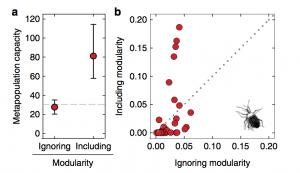Network modularity reveals critical scales for connectivity in ecology and evolution
Fletcher Jr, Robert J., Andre Revell, Brian E. Reichert, Wiley M. Kitchens, Jeremy D. Dixon, and James D. Austin. “Network modularity reveals critical scales for connectivity in ecology and evolution.” Nature communications 4 (2013).
Based on connectivity and patch quality, conservationists need to prioritize species and populations with population viability analyses. This article analyzes the importance of network modularity, or the idea that patches interact most strongly within a set group of other patches (i.e., “patches are cliquey”), on predictions of patch importance and meta-population viability. Network modularity is a concept that has been popularized by social network models seeking to identify influential groups of individuals in populations. In a previous study of modular vs. non-modular meta-populations, the most persistent meta-populations were those that were modular. However, the importance of modularity is debated because it is tightly linked to geographical distance to other patches.
This analysis tested an algorithm designed to unlink the effects of modularity and geographical distance on network dynamics. To understand the impacts of non-distance based modularity on patch importance and viability they analyzed movement data from four populations which varied in the span of their spatial movements. Two datasets were mark-recapture datsets (cactus bug and snail kite) and the other two were genetic data on breeding aggregations (bullfrog and blackbear). Three of the four populations were modular (cactus bug, kite, and bullfrog) when distance was ignored but only two remained modular (bullfrog and cactus bug) when they adjusted their estimations based on a recently developed algorithm for social network data that includes distance. They also analyzed the role of modularity on patch importance. They found that patches were generally important for either connectivity within modular or between modules but rarely both. Finally, they showed that modularity drastically increased the predicted viability assessment of cactus bugs.

They suggest that modularity in these populations could be due to (1) the idea that groups of patches are surrounded by more “resistant” areas (e.g., in the case of cactus bugs, tall grass) or (2) the idea that individuals are attracted to high quality resources and away (e.g., groups of larger cactii). They only found significant statistical evidence of the latter mechanism. Further criticisms of network modularity remain open avenues for further research. Future research could examine ensemble approaches to get around modular requirements of “hard partitioning” and “degeneracy” of groupings. Overall, this paper is interesting for our course because it reveals the importance of “meso-scales” within ecosystems and show how including these scales can lead to drastically different predictions than when ignoring certain scales.

